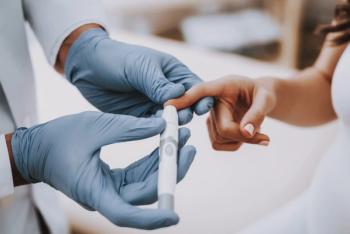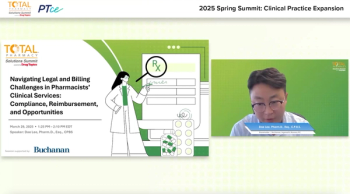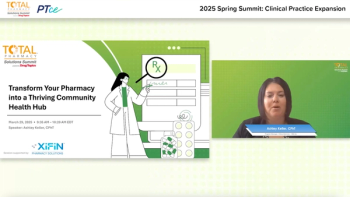
Mark Garofoli, PharmD, MBA, BCGP, CPE, CTTS, discusses effective strategies for balancing excellent patient care with strict regulations surrounding controlled substances.

Mark Garofoli, PharmD, MBA, BCGP, CPE, CTTS, discusses effective strategies for balancing excellent patient care with strict regulations surrounding controlled substances.

David Blair, CEO of LucyRx, joined Drug Topics to discuss the initiatives his company is conducting in support of a struggling pharmacy profession.

The FDA approved adalimumab-aaty in May 2023 for 8 indications, including rheumatoid arthritis, psoriatic arthritis, Crohn disease, ulcerative colitis, and plaque psoriasis.

One asymptomatic patient did experience drug-induced liver injury that was resolved after discontinuation of danuglipron.

At AAP 2025, Douglas Hoey, CEO of NCPA, discussed the possibility of PBM reform under the new administration and his take on Optum Rx’s plans to introduce a cost-plus reimbursement model.

In a telephone audit, researchers attempted to quantify the frequency of patient barriers when looking to purchase sterile syringes from community pharmacies for over-the-counter use.

First-in-class brensocatib has the potential to be the first approved treatment for bronchiectasis.

With transitions of care inclusive of multiple health care settings, each provider must play a specific role to ensure overall improved patient outcomes.

Researchers explored TikTok’s role in the dissemination of information regarding isotretinoin and its users.

At AAP 2025, Ron Friedman discussed best practices for responding to a DEA inspection, how to identify any red flags, and best practices for dispensing.

However, patients should still be monitored for potential serious adverse effects, as investigators identified potential new concerns.

Furthermore, C-reactive protein has greater prognosis for lung cancer, colorectal cancer, and ovarian cancer.

Allergy season is here. Help your patients tackle sneezing, itching, and congestion with this guide to the best OTC treatments.

DeLon Canterbury, PharmD, BCGP, discusses how his career journey led him to medication deprescribing and advocating for older adults.

At the American Associated Pharmacies Annual Conference, Douglas Hoey, RPh, MBA, discussed what needs to change in the program so that it does not hurt pharmacies and patients.

A conversation with Mark Garofoli, PharmD, MBA, BCGP, CPE, CTTS, at the American Associated Pharmacies 2025 Annual Conference.

Collaborative practice agreements enable pharmacists to leverage their expertise beyond traditional dispensing, but barriers continue to limit their implementation.

Researchers explored the association of a pneumococcal polysaccharide vaccine booster and health care utilization in children with sinusitis and low pneumococcal antibody titers.

Dae Lee, PharmD, Esq, CPBS, discusses the legal and billing challenges hindering pharmacy practices and opportunities to overcome them.

David Blair, CEO of LucyRx, discusses the common challenges his clients face and how his company’s innovative model can help them overcome financial hurdles.

A conversation with Scott Biggs and Greg Mitchell at the American Associated Pharmacies 2025 Annual Conference.

The drug is also approved for adults with chronic inflammatory demyelinating polyneuropathy.

The new approval is the first nonopioid option for moderate to severe acute pain in adults.

The designation addresses the unmet need for prevention of H5N1, which remains a global health risk, and a phase 1 trial of the vaccine was initiated in November 2024.

Ashley Keller, CPhT, hosted a session at the Total Pharmacy Solutions Summit Spring 2025 exploring the services and strategies community pharmacies can employ to make their businesses thrive.

Throughout her research, Jenny Markell, BA, has uncovered some alarming trends within prescription drug advertising in the US.

Using a cost-utility analysis, researchers addressed the cost-effectiveness of pneumococcal vaccine strategies for adults over the age of 64.

A conversation with Douglas Hoey, CEO of the National Community Pharmacists Association, at the American Associated Pharmacies 2025 Annual Conference.

Pharmacists have positive impacts on health outcomes for diabetes and patients using CGM devices, including reductions in A1c.

Investigators find 5 distinct obesity trajectories that influenced brain morphology, function, and cognition.